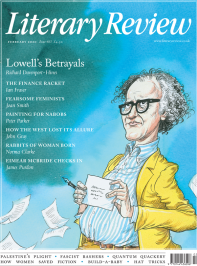Sarah Ditum
The Heat is On
Weather
By Jenny Offill
Granta Books 207pp £12.99
‘I’ve always had an obsession with lost books, all the ones half written or recovered in pieces,’ says Jenny Offill’s narrator in Weather. That narrator is very like, but not the same as, the narrator of Offill’s previous novel, Dept. of Speculation: she’s a New Yorker, writerly, academic-ish, married with one child, and preoccupied with existential fear. In Dept. of Speculation, the fear was that by becoming a wife and a mother, the unnamed narrator had burned her opportunity to become an ‘art monster’. How to be an art monster when the mundane demands of home and baby have ‘cut the day up into little scraps’?
Dept. of Speculation’s form was a kind of answer to that problem, and Weather follows the same lines. ‘Half written or recovered in pieces’ could describe Offill’s own style: short, luminous paragraphs, with a story dispensed through implication and allusion rather than conventional exposition. It is the sort of writing which suggests the brief intervals of liberty that punctuate days of maternal drudge, the shafts of light between clouds of obligation. Offill has invented a literature of the scraps, and as a creature of the scraps myself, I am grateful. I read Dept. of Speculation and now Weather with hungry recognition. The resonance between the world she describes and the one I live in is so emphatic that reading her can feel like having my own interior narrative externalised – a disarming sensation that is a mark of her craft.What has changed in Weather? The child is a boy, not a girl. The narrator has a name this time: Lizzie. Her orbit has expanded to include not just child and husband (called Ben), but a drug-addicted brother, a Bible-thumping mother and an intellectual mentor as well. And the nature

Sign Up to our newsletter
Receive free articles, highlights from the archive, news, details of prizes, and much more.@Lit_Review
Follow Literary Review on Twitter
Twitter Feed
Though Jean-Michel Basquiat was a sensation in his lifetime, it was thirty years after his death that one of his pieces fetched a record price of $110.5 million.
Stephen Smith explores the artist's starry afterlife.
Stephen Smith - Paint Fast, Die Young
Stephen Smith: Paint Fast, Die Young - Jean-Michel Basquiat: The Making of an Icon by Doug Woodham
literaryreview.co.uk
15th-century news transmission was a slow business, reliant on horses and ships. As the centuries passed, though, mass newspapers and faster transport sped things up.
John Adamson examines how this evolution changed Europe.
John Adamson - Hold the Front Page
John Adamson: Hold the Front Page - The Great Exchange: Making the News in Early Modern Europe by Joad Raymond Wren
literaryreview.co.uk
"Every page of "Killing the Dead" bursts with fresh insights and deliciously gory details. And, like all the best vampires, it’ll come back to haunt you long after you think you’re done."
✍️My review of John Blair's new book for @Lit_Review
Alexander Lee - Dead Men Walking
Alexander Lee: Dead Men Walking - Killing the Dead: Vampire Epidemics from Mesopotamia to the New World by John Blair
literaryreview.co.uk